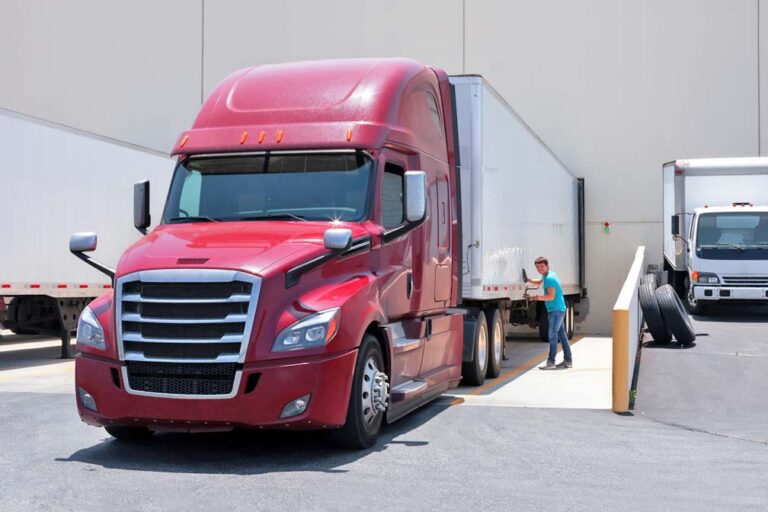WASHINGTON — The federal government is moving forward with a plan to allow teenagers to drive big rigs from state to state in what has become one of the most hotly debated issues in the trucking industry today.
According to current law, truck drivers must be at least 21 to cross state lines, but the new apprenticeship program will let 18- to 20-year-old truckers deliver goods outside their home states.
The apprenticeship pilot program was required by Congress as part of the infrastructure bill signed into law Nov. 15, 2021. It requires the Federal Motor Carrier Safety Administration (FMCSA) to start the program within 60 days.
The U.S. Department of Transportation (DOT) offered full details of the pilot program in late January. It will be regulated through the FMCSA, which will screen the teens to ensure that they don’t have any driving-while-impaired violations or traffic tickets for causing a crash.
Dave Dein, a high school instructor in California who teaches teens how to drive big rigs, said the apprenticeship program is something he has wanted to see for a long time.
“A product that is manufactured/produced in a state can be driven all over that state by a CDL holder under the age of 21, but if that same product is sent to a different state then it is considered interstate commerce and anyone who transports that product within the boundaries of the new state must be at least 21 years old,” said Dein, who also serves as co-chair for the NextGen Trucking organization.
In late 2021, Dein drafted a letter on behalf of Next Gen Trucking to U.S. Transportation Secretary Pete Buttigieg in support of the apprenticeship program, writing: “The supply chain crisis requires new thinking. We believe a change in regulations would enable 18-year-old drivers a rewarding career, uphold safety and help America’s supply chains.”
But safety advocates point to data showing that younger drivers are involved in more crashes than older ones. They claim it’s not a good idea to allow teenage drivers to be responsible for 18-wheelers.
The American Trucking Associations (ATA) supports the program and says it will help with a shortage of drivers. The group has continually said that the U.S. is running over 80,000 drivers short of the number it needs, as demand to move freight reaches historic highs.
Under the apprenticeship, younger drivers can cross state lines during 120-hour and 280-hour probationary periods, as long as an experienced driver is in the passenger seat. Trucks used in the program must have an electronic braking crash mitigation system, a forward-facing video camera, and their speeds must be limited to 65 mph.
After probation, they can drive on their own, but companies must monitor their performance until they are 21. No more than 3,000 apprentices can take part in the training at any given time.
The FMCSA must reach out to carriers with excellent safety records to take part in the program, according to the DOT.
The program will run for up to three years, and the motor carrier agency has to turn in a report to Congress analyzing the safety record of the teen drivers and making a recommendation on whether the younger drivers are as safe as those 21 or older. Congress could expand the program with new laws.
The test is part of a broader set of measures from the Biden administration to deal with the trucker shortage and improve working conditions for truck drivers.
“This program creates a rigorous safety training program, requiring an additional 400 hours of advanced safety training, in which participants are evaluated against specific performance benchmarks,” said Nick Geale, vice president of workforce safety for ATA.
The program will ensure that the industry has enough drivers to meet growing freight demands, he said.
But Peter Kurdock, general counsel for Advocates for Highway and Auto Safety, told the Associated Press that federal data shows that younger drivers have far higher crash rates than older ones.
“This is no surprise to any American who drives a vehicle,” he said.
Putting teens behind the wheel of trucks that can weigh up to 40 tons when loaded increases the possibility of mass casualty crashes, he said.
Kurdock said the trucking industry has wanted younger drivers for years and used supply chain issues to get it into the infrastructure bill. He fears the industry will use skewed data from the program to push for teenage truckers nationwide.
Reaction among current professional truck drivers about the program has been widely mixed.
The Owner-Operator Independent Drivers Association (OOIDA) said it is concerned about the apprenticeship program on several levels.
OOIDA president and CEO Todd Spencer outlined the association’s concerns in a Jan. 12 letter to Thomas Keane, associate administrator for the Office of Research and Registration at the FMCSA.
“We believe that licensing under-21 drivers for interstate commerce will lead to more crashes, injuries and fatalities involving large trucks, especially if (it) is implemented without establishing comprehensive safety oversight,” Spencer wrote.
Additionally, Spencer wrote that the program “falls short on outreach to smaller carriers.”
“We expect it will be difficult for many motor carriers to afford insurance coverage for younger drivers,” he wrote. “Small-business motor carriers are especially unlikely to take the risk of insuring under-21 drivers when evaluating the costs and benefits to their operations.”
Jo Franklin, who is a long-haul driver from Wisconsin, said he understands that there is a need for more truck drivers, but “I just don’t think a teenager can safely pilot a big rig across the country.”
J.S. Williams has been a truck driver for more than 25 years and said she is fine with the proposal.
“I mean, more power to them,” Williams said. “I think it’s great, and it will give a new generation of people a great career. I don’t understand why so many people are against this. I think it’s super.”
The Associated Press contributed to this report.
Born in Pine Bluff, Arkansas, and raised in East Texas, John Worthen returned to his home state to attend college in 1998 and decided to make his life in The Natural State. Worthen is a 20-year veteran of the journalism industry and has covered just about every topic there is. He has a passion for writing and telling stories. He has worked as a beat reporter and bureau chief for a statewide newspaper and as managing editor of a regional newspaper in Arkansas. Additionally, Worthen has been a prolific freelance journalist for two decades, and has been published in several travel magazines and on travel websites.















Aaaaaannnnnnd Big Brother sticks it to us again.
I spent 39 years over the road, with over 4 1/2 MILLION miles of not even a parking ticket. I would like to think that most of the credit for that goes to the fact I had from the ages of 16 to 21 to learn how to safely use a steering wheel and the vehicle it was attached to, with the help of older drivers and instructors.
These days, in the age of “every man/woman for themselves” this type of education is more than just passe. It is non existent. Add to that the current administration wanting to revive Orson Wells’ way of thinking (the movie 1984) and prepare yourself to be ready for the kid that might have bumped you at a red light in his Honda running you over like a road pizza in his Peterbilt.
I’m glad I got out.